
Middlesex Canal Association P.O. Box 333 Billerica, Massachusetts 01821
www.middlesexcanal.org

Middlesex Canal Association P.O. Box 333 Billerica, Massachusetts 01821
www.middlesexcanal.org
| Volume 62 No. 3 | April 2024 |
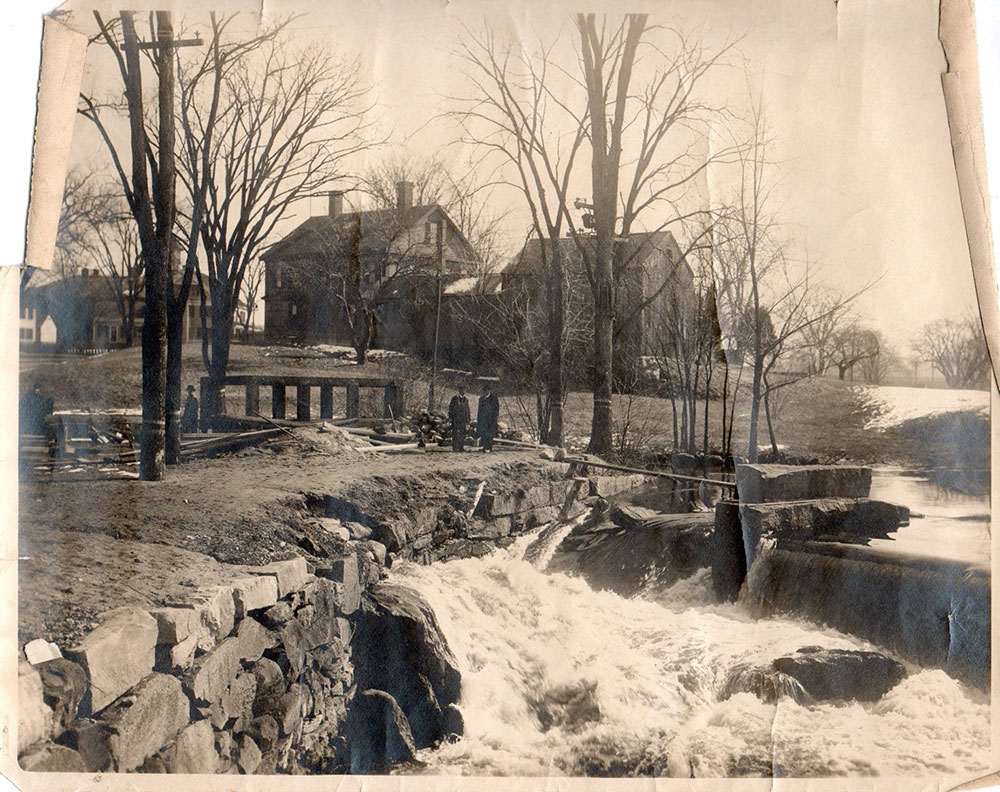
Picture showing the fishway in the Talbot Mills Dam. (Circa 1900).
Courtesy of the Billerica Historical Society
TABLE OF CONTENTS
MCA Sponsored Events and Directions to the MCA Museum and Visitors’ Center
President’s Message from J. Jeremiah Breen
Section 106 Letter: Re: Talbot Mill Dam by Tom Lincoln
Spring Walk 2024 Report by Robert Winters
The Governor’s Mansion by Alec Ingraham
President’s Page from 1974 by Douglas Adams
Tribute to Douglas Adams by Col. Wilbur Hoxie
Editors’ Letter
Hello Readers!
This issue starts out with a follow-up to the dam removal issue from October 2023. Reprinted, with permission, is the letter MCC Chair Tom Lincoln has sent to Eric Hutchins outlining the importance of the dam and proposing alternatives to its removal.
In our quest to bring the Towpath Topics past to new readers and memories to long time subscribers, we have reprinted the President’s Message from the April 1974 issue. To “round out” the picture of President Douglas Adams, we have also included his obituary and a tribute from Col. Wilbur Hoxie. Any members who would like to share their memories of President Adams will be added to the September issue.
As our usual, please find the current President’s Message from J. Breen, the calendar of MCA Events, directions, an item on Gov. Talbot’s North Billerica Mansion, and miscellany.
Please consider sending in any ideas for future articles or current research you might be working on, to add to our September issue.
See you at the April 28th annual meeting!
The Editors
MCA Sponsored Events – 2024 Schedule
Annual Meeting: 1:00pm, Sunday, April 28, 2024
MCA President J. Jeremiah Breen will comment on and add to the Burbeen Series
- Woburn Historical Society lecture by Campbell, Cory and Maguire.
Meet in the Reardon Room of the museum, 71 Faulkner Street, Billerica, MA 01862.
22nd Fall Bike Tour: 9:00am, Saturday, October 5, 2024
Meet at the Middlesex Canal plaque right at the entrance to Sullivan Square T Station,
1 Cambridge Street, Charlestown, MA 02129.
Leaders will be Dick Bauer and Bill Kuttner.
Fall Walk: 1:30pm, Sunday, October 13, 2024 – Billerica North to Chelmsford
Meet at Billerica Falls, 71 Faulkner Street, Billerica, MA 01862.
Fall Meeting: 1:00pm, Sunday, October 27, 2024
Speaker TBA
The Visitors Center/Museum is open Saturday and Sunday, Noon – 4:00pm, except on a holiday.
The Board of Directors meets the 1st Wednesday of each month, 3:30-5:30pm, except July and August.
Check the MCA website for updated information during the COVID-19 pandemic.
Annual Meeting, 1:00pm, Sunday, April 28, 2024
Meet in the Reardon Room of the museum, 71 Faulkner St, Billerica 01862.
The president of the Middlesex Canal Association, J. Jeremiah Breen, will comment on and add to the Feb. 13, 2012 Burbeen Series - Woburn Historical Society lecture by Campbell, Corey, and Maguire – “The Middlesex Canal - Woburn’s First Interstate, Then and Now”
YouTube: https://www.youtube.com/watch?v=Lh0rSYh8-b8
For more information on the Fall Walk and the 22nd Annual Bicycle Tour please access the MCA website, www.middlesexcanal.org.
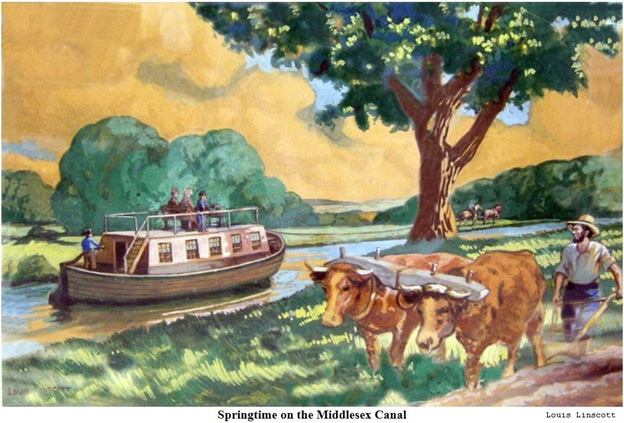
Directions to Museum: 71 Faulkner Street in North Billerica, MA
By Car
From Rte. 128/95
Take Route 3 (Northwest Expressway) toward Nashua, to Exit 78 (formerly Exit 28) “Treble Cove Road, North Billerica, Carlisle”. At the end of the ramp, turn left onto Treble Cove Road toward North Billerica. At about ¾ mile, bear left at the fork. After another ¼ mile, at the traffic light, cross straight over Route 3A (Boston Road). Go about ¼ mile to a 3-way fork; take the middle road (Talbot Avenue) which will put St. Andrew’s Church on your left. Go ¼ mile to a stop sign and bear right onto Old Elm Street. Go about ¼ mile to the bridge over the Concord River, where Old Elm Street becomes Faulkner Street; the Museum is on your left and you can park across the street on your right, just beyond the bridge. Watch out crossing the street!
From I-495
Take Exit 91 (formerly Exit 37) North Billerica, then south roughly 2 plus miles to the stop sign at Mt. Pleasant Street, turn right, then bear right at the Y, go 700’ and turn left into the parking lot. The Museum is across the street (Faulkner Street). To get to the Visitor Center/Museum enter through the center door of the Faulkner Mill and proceed to the end of the hall.
By Train
The Lowell Commuter line runs between Lowell and Boston’s North Station. From the station side of the tracks at North Billerica, the Museum is a 3-minute walk down Station Street and Faulkner Street on the right side.
President’s Message, “Sec. 106 Alternatives to Dam Removal”
by J. Breen
Eric Hutchins, a fisheries biologist at the National Oceanic and Atmospheric Administration (NOAA), held a meeting March 19, 2024 with the consulting parties to NOAA’s proposed Talbot Dam Removal as required by the National Historic Preservation Act of 1966, Section 106. The Middlesex Canal Association as voted by its directors on March 2, 2016 is opposed to the removal of the Billerica Falls Dam and the draining of the summit pond.
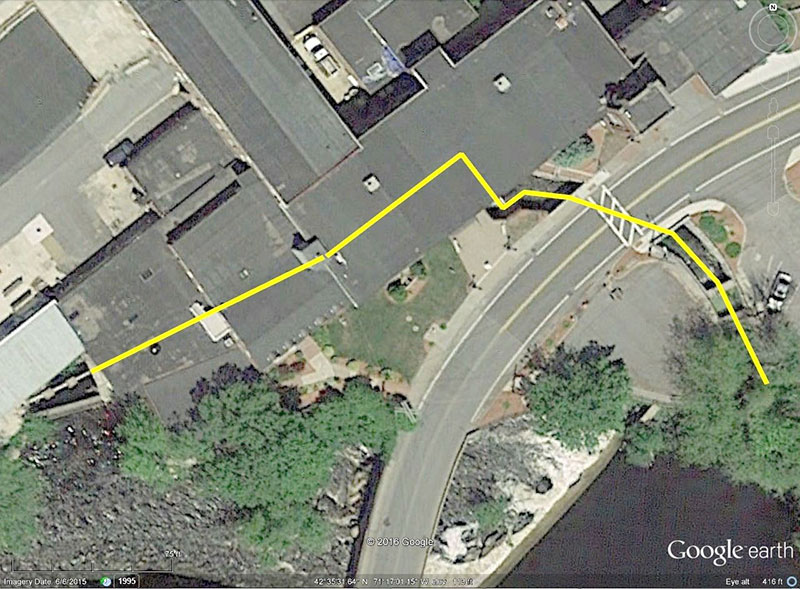
Faulkner Canal in yellow, 12’ wide x ~400’
Section 106 requires NOAA to explore measures to avoid or reduce the adverse effects on historic properties, the 1828 dam and summit pond. If the primary benefit of dam removal is migration of diadromous fish, then a fishway in the Faulkner Canal would avoid any harm to the dam and summit pond.
A plexiglass trough, 4’ x 4’ x <200’, with Denil baffles would easily fit in the canal and the 71 Faulkner St. basement. With a sandbag dam at both ends of the canal, the fishway could be built in the dry. Let’s score this simple construction at 100.

Artist rendering of fish ladder alternative to dam removal in the 2016 Diadromous Fish Feasibilty Study 1
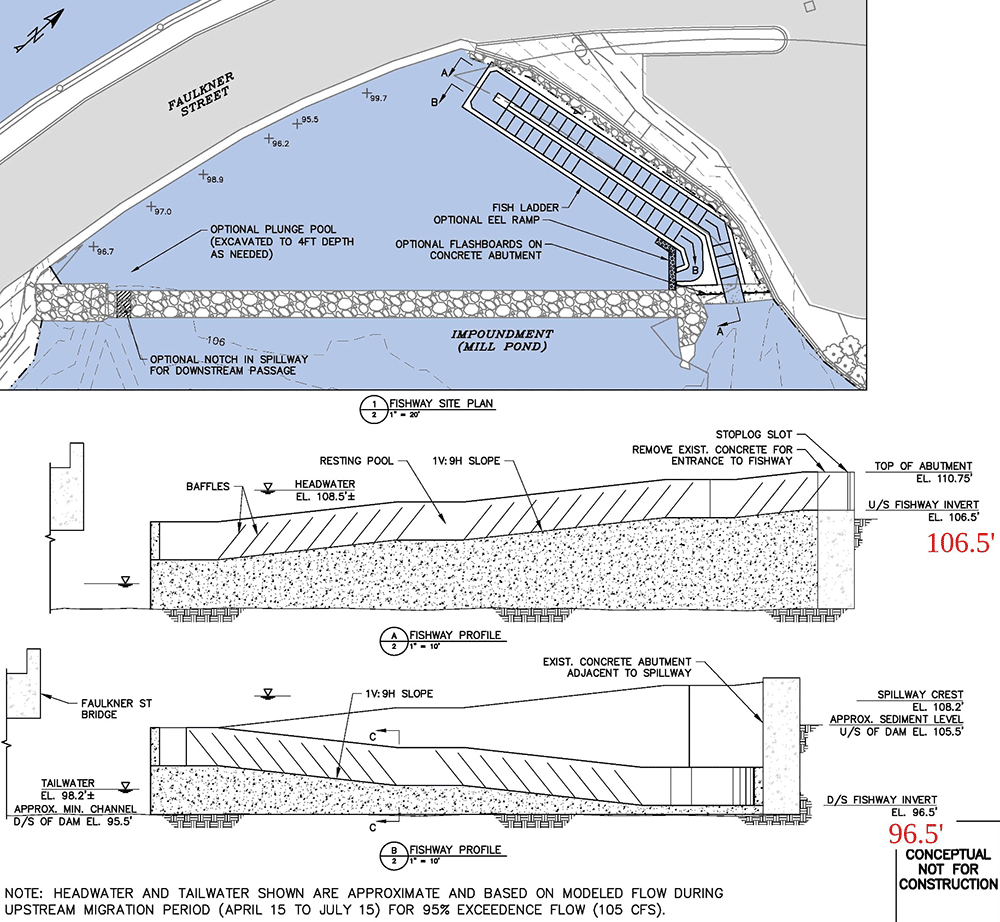
The massive masonry 4’ x 4’ fishway considered as an alternative to dam removal by NOAA in the 2016 Feasibility Study is zero.
The Middlesex Canal Association’s preferred alternative to removing the dam is renovating it. The 1828 dam was built with a fishway now blocked with concrete at its entrance.
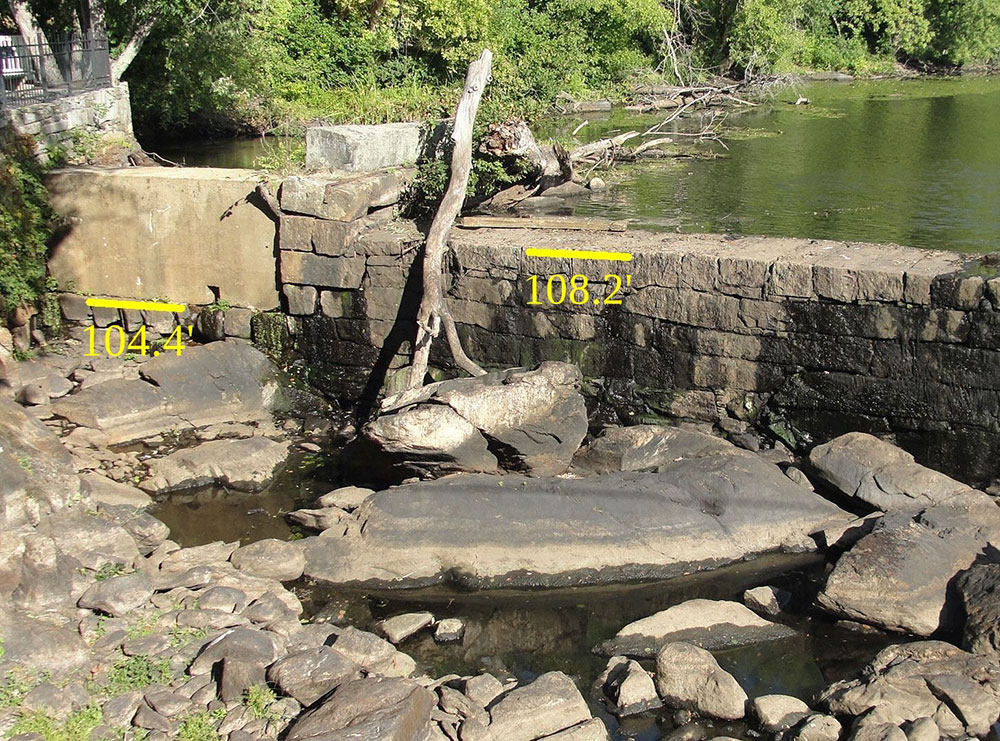
Note well that the 1828 fishway has a rock ramp up to the entrance sill at elevation 104.4’ (NAVD 1988). The lift is 108.2 - 104.4’ = 3.8’. NOAA’s alternative lift is 106.5’ - 96.5’ = 10.0’, or 10 ÷ 3.8, 260% greater, another reason besides artistic license that NOAA’s masonry alternative is massive. The fishway at the Centennial - Wamesit Falls Dam, 3 miles down river from the Billerica Falls, is a better possibility of what size a renovated 1828 fishway would be.
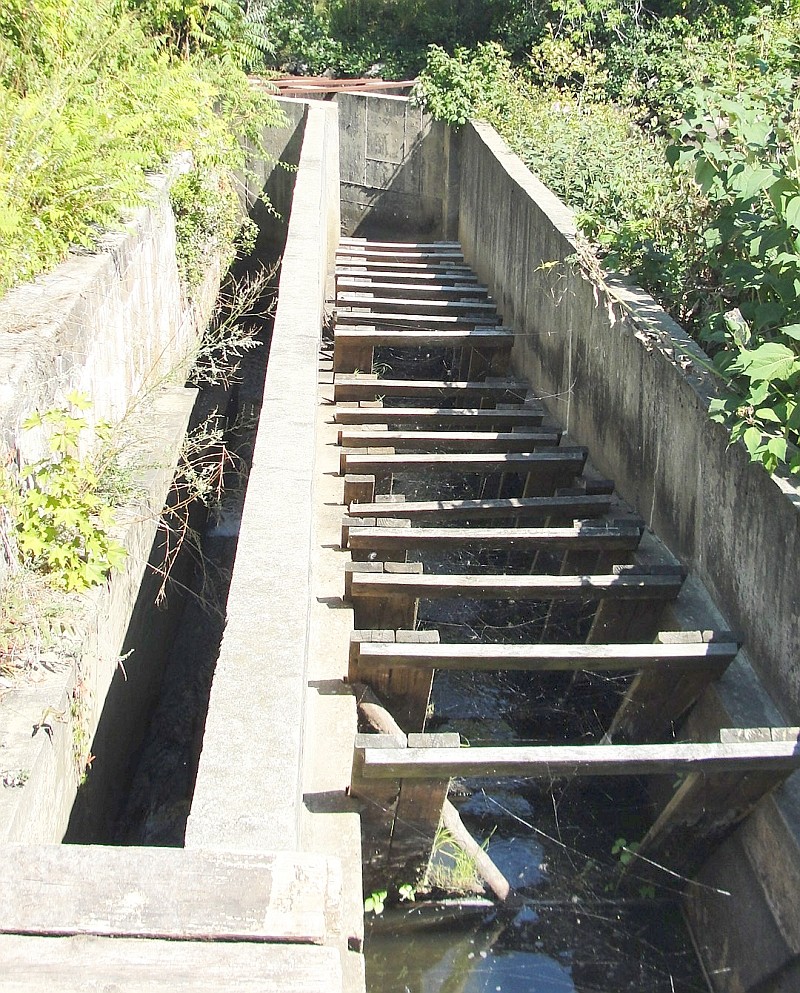
A modern fishway in the place of the 1828 fishway and replacement gates in the left abutment low-level outlet and in the Faulkner Canal are a simple, two-step solution to fish migration. With flow regulation by gates to benefit the fish, neither too low, nor too fast, just right, the score for the fish is 110.
And Future Generations will still have the benefit as prayed at the 1794 groundbreaking of using and enjoying a major part of John Hancock’s water highway which low cost transportation started the Industrial Revolution in Massachusetts using Merrimack River waterpower. Happy fish and preserved historic resources, what could be better?
Notes:
1. Concord River Diadromous Fish Restoration: Feasibility Study: Final Report prepared by Gomez and Sullivan, Engineers, 2016. http://archives.lib.state.ma.us/handle/2452/626310 N. B., the appendices, A - I, are separate files.

March 28, 2024
Mr. Eric Hutchins
NOAA - GARFO
55 Great Republic Drive
Gloucester, MA 01930
Re: Talbot Mills Dam Project (Project) – Section 106 Proposal for the Memorandum of Agreement (MOA) with the Middlesex Canal Commission – [Submitted via USPS and via e-mail]
Dear Mr. Hutchins:
The Middlesex Canal Commission (MCC) has status as a consulting party in the Section 106 process for NOAA’s (and partners’) Talbot Mills Dam Project (Dam Removal). The MCC has been chartered by the Commonwealth of Massachusetts to preserve and interpret the historic Middlesex Canal (Canal). The Canal stretched from Charlestown to Lowell; the extant Talbot Mills Dam, Summit Pond and adjacent towpaths are all within the scope of the Project. These historic resources are part and parcel of the Billerica Mills Historic District. The entire Middlesex Canal is a National Register Historic District.
The Section 106 process is designed to provide alternatives to negative impacts on historic resources, and, if alternatives are not possible, to fully mitigate concomitant damages. We have addressed both aspects of Section 106 in this submission. As has been acknowledged in Project plans, the proposed removal of all or a portion of the Dam would destroy historic resources. In doing so, it would make it impossible to adequately interpret the Canal at one of its most important sections. Below are the MCC’s formal proposals for the Section 106 process.
A – Proposed Alternative to Dam Removal (Retention of the Dam and Provision of Fish Passage)
1 – MCC will accept Dam ownership under these conditions:
- An Inspection and Maintenance account is funded for use by MCC, with sufficient principal to generate funds for required inspections and repairs
- A fish ladder, fishway or other appropriate device is restored/installed to ensure safe passage of migratory fish, in accordance with the goals of the Project and environmental benefits. NOAA and/or other Project Proponents will fund said restoration/installation.
2 – MCC will maintain the Dam per the requirements of the Commonwealth of Massachusetts.
3 – MCC will work with OARS, trails advocates, MCA, and other interested parties to integrate a bike trail and/or similar recreational facilities with the Middlesex Canal site at the Talbot Mills Dam and Summit Pond location.
B - Mitigation in the Event the Talbot Mills Dam is Removed in Whole or in Part
1 – Prior to removal of the Dam and elimination of the Summit Pond, the Proponent and its Project Partners will mitigate the loss of historic resources at the Dam site, Summit Pond site and any other affected portion of the historic Canal footprint or· viewshed, by financially compensating the MCC in an amount sufficient to remediate the following losses and damages:
a) Monies already spent by the MCC in planning the proposed Middlesex Canal Heritage Park at the Site, including the replication/suggestion of the historic floating towpath across the Concord River;
b) Compensation for the permanent loss of irreplaceable historic resources in an amount sufficient to allow the MCC and its partners to adequately interpret the history of the Canal at the site;
c) Mitigation funds sufficient to enable the MCC to provide suitable “on this site” interpretive signage and related visitor infrastructure for the public at the Dam and Summit Pond sites. Note: Sections 1(b) and 1(c) are cumulative, not mutually exclusive.
2 – The MCC agrees to cooperate and assist the Project Proponents in the achievement of the Project goals of improving fish migration, water quality, and the like.
3 – The MCC agrees to help advance the completion of a bike path and/or other passive recreational facilities proposed by other entities, OARS, and the like, provided said facilities protect historic Canal resources.
Summary:
We sincerely hope that the parties do not have to apply the provisions of “B” above. We believe the proposed alternative outlined in “A” above provides a reasonable and logical pathway to advance important Project goals, while ensuring the survival of irreplaceable historic resources.
Destroying the historic Talbot Mills Dam and Summit Pond just because it might be convenient is a clear injustice, as well as a violation of Section 106. We are all for ecological restoration: fish ladders or other passage devices have been used successfully here and many other places for decades. Secondly, we are confident that Alternative “A” will save money since the Project faces major costs for dam removal, archeological digs, and other sitework, even before the mitigation requirements of Section 106 would apply. Finally, retention of the Dam will safeguard Billerica’s water supply and satisfy abutters’ concerns.
We look forward to further discussion as the Memorandum of Agreement is drafted with us and other consulting parties, and to working with the Project Proponents and the SHPO to ensure the future of the Middlesex Canal site along the Concord River in North Billerica. Thank you.
Sincerely yours,
Thomas W. Lincoln, MCC Chair
CC (by e-mail): MCC Commissioners; Brona Simon, SHPO; Bob Martin; J. Breen (MCA); Rep. David A. Robertson; John Curran (Billerica Town Mgr.); David Gagliardi (HDC); Jennifer Raitt (NMCOG); Richard Hawes (BHS); Matthew Brown (OARS); Marlies Henderson; Andrew Jennings; David Robinson (BUAR)
Spring Walk - 2024
by Robert Winters
On March 17, 2024, about 25 participants joined us for our Spring Walk in Winchester/Medford starting at Shannon Beach on the Upper Mystic Lake. The walk was led by Robert Winters with the welcome assistance of Roger Hagopian and Neil Devins. This canal segment features the southernmost visible remnants of the Middlesex Canal, and with the trees still bare it was quite easy to point out the levels and the profile of the canal along the Mystic Valley Parkway.
There were many question from our eager and interested participants, especially at the site where the aqueduct over the Aberjona (Symmes) River once stood, and at the former site of the Brooks Bridge near the Sagamore John monument on Medford’s Sagamore Street. We had the pleasure of speaking with neighbors who noted that some of the stones of the Brooks Bridge were incorporated into the foundations of their homes.
This year we extended to walk slightly to visit the nearby Pomp’s Wall - a wall built long ago before the Middlesex Canal by an enslaved man named Pomp for the Brooks family. This was a great addition to our usual route. Walk participants were very interested in the history with some doing research with their phones as we walked and sending additional historical references via email after the walk.
More information from the Medford Historical Society:
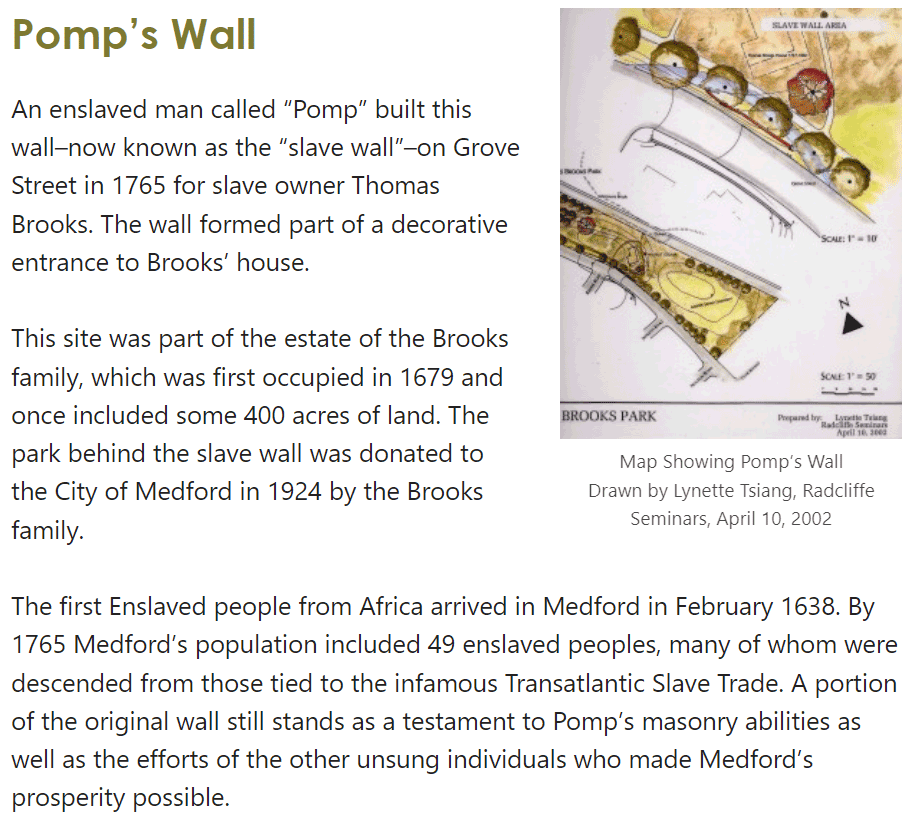
The Governor’s Mansion
by Alec Ingraham
The Governor’s Mansion once stood near the intersection of Mount Pleasant Street and Doris Avenue. The mansion was built by Governor Thomas Talbot, who was elected the Governor of the Commonwealth of Massachusetts in 1878. Talbot was a well-to-do businessman who, along with his brother, Charles P. Talbot, operated a successful woolen mill and chemical works in North Billerica. In 1851, the brothers purchased the land, water power, dam, land and buildings and Concord River Mill Pond in North Billerica from the Proprietors of the Middlesex Canal. Although Charles chose Lowell as his place of residence, Thomas preferred Billerica. He even, at times, during the incendiary fires in 1844, would sleep in the brothers’ North Billerica mill buildings to discourage vandalism and arson.
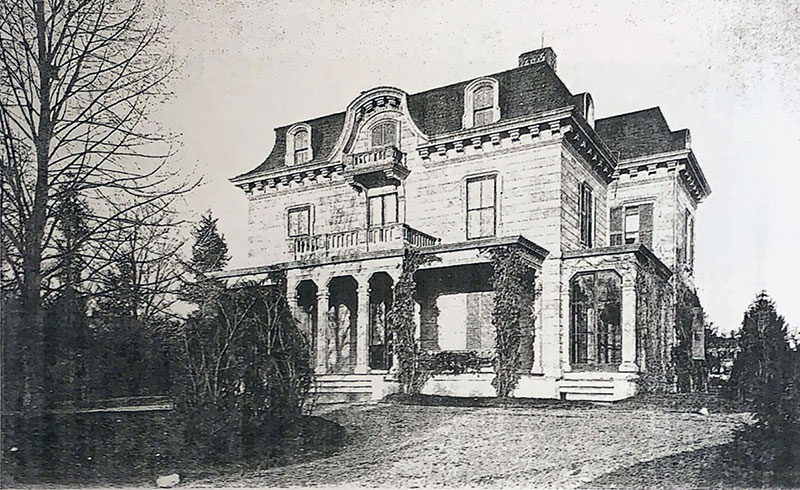
Residence of Hon. Thomas Talbot
In addition to the Mansard style mansion, the estate contained roughly 8 acres of land with barns, tree lined drives, outbuildings and even a windmill. The house faced the Boston & Lowell Railroad, an enterprise of which Thomas was a director. A stone wall, running along the south side of Mount Pleasant Street is all that remains of the grand house. Gate posts to the mansion entrances are still extant framing the driveways at 19 and 29 Mount Pleasant.
It is believed Gov. Talbot built the house on land purchased from Calvin Rogers, father of his first wife, Mary Howe Rogers. Tragically, she passed away within three years of their marriage. In 1855, Gov. Talbot married Isabella W. Hayden of Haydenville, MA. Her father, Joel Hayden, was a noted industrialist and prominent citizen of the Bay State. It is believed construction of the mansion was concurrent with their marriage. At the time, the Mansard style of architecture had just become popular in the United States, but it was not until 1870 that the mansion was fully assessed by the Town.
Governor Talbot passed away in 1885 and his wife in 1910, after which time the mansion was only sparingly used by the family. Isabella’s will provided that the estate, with a stipend of $40,000 for its maintenance, be left to her oldest son, Col. Thomas Talbot. Unfortunately, he predeceased her. This delayed the settlement of her will. In 1920, the mansion was sold by Isabella’s estate to Jane A. McBride of Belmont, MA. The same year she subdivided the property into thirty-four lots. Included in the plan were two new streets, Doris Avenue, which ran perpendicular to Mount Pleasant Street at the eastern end of the estate and Francis Street which ran parallel and south of Mount Pleasant Street.
Jane, a widow since 1900, moved into the estate, living in part of the mansion and renting other sections of the large house. In 1937, she sold the Governor’s Mansion to the City Institution for Savings in Lowell. At this time only one or two lots along Doris Avenue had been sold. During the ensuing years the mansion had fallen into disrepair. In October of 1941, it was razed and soon after the lots along Mount Pleasant Street were advertised for sale.
Editors’ Note: We thought the readers would be interested in this President’s Report from fifty years ago. It was excerpted from the April 1974 issue (Vol. 12; No. 1) of Towpath Topics. For those of you who remember Douglas, please share your memories. They will be printed in the fall issue of Towpath Topics.
PRESIDENT’S PAGE
CONCERNING THE CANAL – each of us in recent years has most likely read in one place or another, “Today no trace of it remains.” Now as we round out the first dozen years of this Association, we observe this same CANAL a feature of major historic interest both locally and throughout the United States. Several books and one Guide have already been written about it, a museum has been started for it. An ancestral house has been moved bodily to its banks, a bridge has been built over it, sections of it are being dredged and one stretch rehabilitated for exhibition. Artifacts associated with it have been found and collected and more will be sought. In fact this “vanished” Canal strip has become an ant-hill of activities concerned with it.
The short-term burst of enthusiasm from Bicentennial years has surely quickened the pace of such progress but it is due and will continue to be due largely to a swelling, national, long-term comfort in that brew from the roots of our past which increasingly proffers a major therapy for ills of our time. This Association, with all its magnificent foundations in technical and humanistic excellence, will continue to ride the crest of this great wave with vigor and enthusiasm, emerging currently into years of its own maturity and major contribution whose full measure and final fruit must presently remain conjectural. The secret lies in the membership, from which must continue to originate and evolve every genus, species or variety of endeavor that is to provide that ultimate measure of success. This Association needs you, but you must come forward.
On Saturday, August 17, 1974, (SAVE THE DATE) there will be a dedication of the rehabilitated section of the CANAL, yes, our CANAL, lying in Wilmington which the Department of Public Works has been able to help us with in conjunction with its relocation of the Route 129 overpass in that town. This is only one example of the broad interests of the DPW, especially as evidenced by the current administration of Commissioner Campbell, whom we hope to have as a speaker at that time. You will surely hear more of this occasion, where we look forward to the presence of the Governor of the Commonwealth and numerous out-of-state Canallers as well.
With respect to the “1790 House” where our meeting of April 27 lies, the North Woburn Congregational Church has graciously permitted us its use; we hope the Reverend Nancy Klassen, Pastor, will be with us. Indicative of interest in the CANAL, Ms. Margaret M. Costello, Middlesex Community College, has written a paper on this House which the Church procured for us and which we hope to reproduce in major part for the meeting. Pending that event, we present a few remarks on this famous structure taken from, “Historic Sites of Woburn”, prepared by the Woburn Historical Commission:-
THE 1790 HOUSE. This magnificent home located on Main Street in North Woburn was originally built in 1790 for a Woburn Lawyer, Joseph Bartlett. Upon completion, however, it was purchased by Baldwin for his friend Rumford who had dreams of returning there. Tho these dreams were never realized, they probably account for the fact that the house was called by some “The Count Rumford House”. The noted author Frances Parkinson Keyes, a frequent guest and visitor to the house, refers to it repeatedly in her memoirs “Roses in December”, as the “Count Rumford House”.
Because of its grand design and pleasant setting it was frequently used for soirees and balls commemorating important events in Woburn. In 1800 it was the scene of a Grand Centennial Hall and in 1803 a gala was held to celebrate the opening of the Middlesex Canal.
Douglas P. Adams
Boston UPI: Douglas Adams Funeral Rites set for Tuesday
Funeral services were planned Tuesday for Douglas Payne Adams, a retired professor of mechanical engineering who fought for years to save historic landmarks in greater Boston.
He died of a heart attack Saturday at his home in the Charlestown section. He was 67.
Adams, whose ancestors date back 200 years in this country, was born in Charlestown, and received his mathematics degree from Harvard in 1930, becoming a Massachusetts Institute of Technology professor in 1939.
A member of 16 historical societies, president of five, he wrote numerous articles about the American Revolution, including, the booklet used at the Battle of Bunker Hill display at Bunker Hill.
In the Charlestown section, Adams helped preserve the Phipps Street Cemetery, four post-revolutionary buildings, the Deacon Larkin House, and the Charlestown Naval Yard.
Deacon Larkin lent Paul Revere a horse for his trip to Concord after Revere crossed the Charles River to warn of the incoming British troops.
Elsewhere, Adams helped preserve Fort Washington in East Cambridge, and the nation’s oldest Canal, the Middlesex Canal, near Wilmington. It once ran from Lowell to Charlestown.
Before his retirement as an active professor at MIT last year, Adams taught several courses, including a seminar called “Birth and Care of a City,” which ran for 12 years.
He leaves his wife, a son, two daughters and six grandchildren.
Services are planned at Christ Church, Cambridge, with burial at Mt. Auburn Cemetery, Cambridge.
(Holyoke Transcript-Telegram: Monday, October 27, 1975; Page #6.)
Editors’ Note: In the April 1976 issue (Vol. 14; No. 2) of Towpath Topics, Col. Wilbur Hoxie wrote a eulogy to Douglas Adams, a past president of the Middlesex Canal Association.
PROFESSOR DOUGLAS P. ADAMS
The Middlesex Canal Association - and historians everywhere - were saddened by the death on October 25, 1975 of this widely-known teacher, author, and most active researcher for the records of our historic heritage. On the faculty of Massachusetts Institute of Technology, his example of accuracy and thoroughness was an inspiration to a generation of young engineers. To all of these, and to hundreds of persons interested in the past, his anecdotes and his writings brought a new remembrance of men and their deeds now all but forgotten. His lifelong studies of early Charlestown were of major effect in our present recognition of its honoured past, - Old Ironsides, the Navy Yard, the Bunker Hill Battle and Monument. His energy was a major influence in reactivation of the Minute Man Company of Charlestown ten years ago, and through its pageantry contributed much to appreciation of the Bicentennial commemorative activities. Fort Washington, not far from his class-room, drew his attention in the 1950’s and through his enthusiasm the City of Cambridge took action to restore the Memorial. His affection for this last remaining American fortification of the Siege of Boston continued to the end of his life. Possibly his last public appearance was at the Bicentennial exercises held at Bunker Hill Monument on June 17, 1975.
As a Canal scholar, Professor Adams was an early Proprietor of the Middlesex Canal Association and he was recognized as an authority on the Boston end of the Canal and the Charles River Mill Dam. He extended his studies to the western limits of 19th Century American Canals in Indiana and Illinois on numerous trips, always photographing, inquiring, and remembering details of early engineering practice. He served as President of the Middlesex Canal Association, of the Bay State Historical League, and as Member and Officer of many other historical societies in Boston, Cambridge and Charlestown.
After apparent recovery from a long illness, his unexpected death leaves a sense of loss to all who have known him. We, his friends, wish Mrs. Adams and the family to know of our sympathetic sharing in his loss, and to appreciate that his works in many fields will be long remembered as an example of the highest professional standards.
Wilbur M. Hoxie
President, Middlesex Canal Association
MISCELLANY
Back Issues - More than 50 years of back issues of Towpath Topics, together with an index to the content of all issues, are also available from our website http://middlesexcanal.org/towpath. These are an excellent resource for anyone who wishes to learn more about the canal and should be particularly useful for historic researchers.
Estate Planning - To those of you who are making your final arrangements, please remember the Middlesex Canal Association. Your help is vital to our future. Thank you for considering us.
Membership and Dues – There are two categories of membership: Proprietor (voting) and Member (non-voting). Annual dues for “Proprietor” are $25 and for “Member” just $15. Additional contributions are always welcome and gratefully accepted. If interested in becoming a “Proprietor” or a “Member” of the MCA, please mail membership checks to Neil Devins, 28 Burlington Avenue, Wilmington, MA 01887.
Middlesex Canal Association Officers and Directors: http://www.middlesexcanal.org/directors.htm
Museum & Reardon Room Rental - The facility is available at very reasonable rates for private affairs, and for non-profit organizations to hold meetings. The conference room holds up to 60 people and includes access to a kitchen and restrooms. For details and additional information please contact the museum at 978-670-2740.
Museum Shop - Looking for that perfect gift for a Middlesex Canal aficionado? Don’t forget to check out the inventory of canal related books, maps, and other items of general interest available at the museum shop. The store is open weekends from noon to 4:00pm except during holidays.
Web Site – The URL for the Middlesex Canal Association’s web site is www.middlesexcanal.org. Our webmaster, Robert Winters, keeps the site up to date. Events, articles and other information will sometimes appear there before it can get to you through Towpath Topics. Please check the site from time to time for new entries.
The first issue of the Middlesex Canal Association newsletter was published in October, 1963.
Originally named “Canal News”, the first issue featured a contest to name the newsletter. A year later, the newsletter was renamed “Towpath Topics.”
Towpath Topics is edited and published by Debra Fox, Alec Ingraham, and Robert Winters.
Corrections, contributions and ideas for future issues are always welcome.
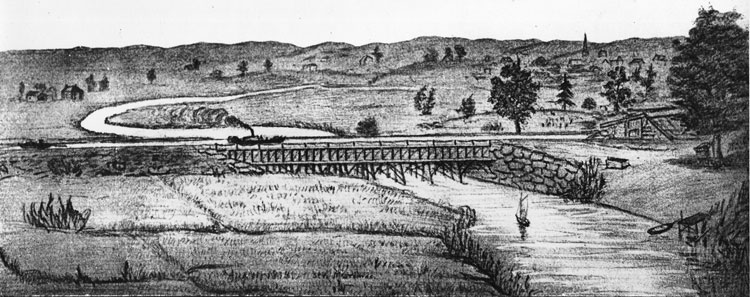
Excerpt from the August, 1818 drawing (artist unknown) of the steam towboat Merrimack crossing the
original (pre-1829) Medford Aqueduct, probably on its way to service on the Merrimack River.